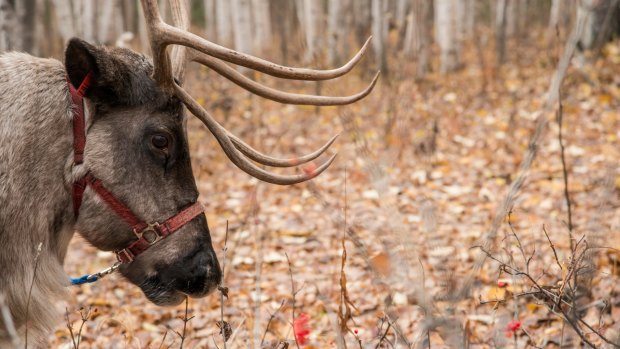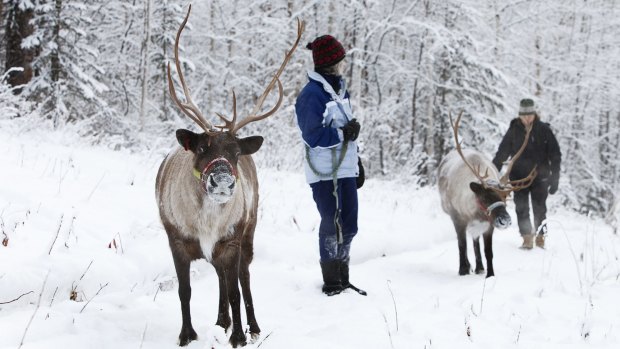This was published 5 years ago
Running Reindeer Ranch, Alaska: The US state where you can hang with adorable reindeer
By Katrina Lobley

A ranch reindeer.Credit: Sherman Hogue/Explore Fairbanks
Life in Fairbanks is extreme. At a latitude of 65 degrees north, a notch below the Arctic Circle, the tilt of Alaska's largest interior city towards and away from the sun means you're visiting either for the shimmering auroras or to bask in the long, languid days of the midnight sun.
I've lobbed in August, right on the cusp of the seasonal changeover. It is only two months since Fairbanks basked in almost 22 hours of daily daylight but the freakish results of all that sunshine are still on show at Pike's Waterfront Lodge ("the friendliest hotel in Fairbanks"). Lurking in the flower and vegetable gardens are beach-ball-sized cabbages – the largest I've ever seen. At the Alaska State Fair at Palmer near Anchorage later that month, a new state record would be set for pumpkins. The biggest weighed an astonishing 913 kilograms. Everything is bigger – and weirder – in Alaska.
I have come to Fairbanks to do something pretty weird. At Running Reindeer Ranch, near Moose Mountain on the outskirts of town, you can stroll through a boreal birch forest with the resident reindeer (in summer, you can do yoga with them). I arrive just before dinnertime when the sun is still high in the sky. Reindeer herder Jane Atkinson and her helpers have already put some reindeer, including gangly juveniles with tiny antlers, out to graze the lawn. Sunbeams light up their velvet antlers. I might be visiting too early in the year for the northern lights but the adorable antler fuzz makes up for it.

Running Reindeer Ranch in winter.Credit: Sherman Hogue/Explore Fairbanks
Atkinson, a no-nonsense, life-long Alaskan, got into reindeer thanks to her persistent daughter. Twelve-year-old Robin was desperate for a pet. Atkinson said she could only have an animal that would thrive in the sub-Arctic, thinking that was the end of that conversation. But when they spotted a university research herd, the family's fate was sealed. Robin found reindeer for sale at Palmer for $US2000 each but, as they're herd animals, she needed two. "I was like, 'Ooh honey, $4000 – you better get on that' and I was sure it wasn't going to happen," says Atkinson. Her daughter proved her wrong and two reindeer arrived in 2007.
Days later, when the new arrivals were still discombobulated from leaving their herd in Palmer, snowfall brought down a tree, which in turn crashed through a fence. The reindeer scrambled out and headed for Palmer, sparking a four-day ground and aerial search, and inspiring the ranch's name. A radio station listener spotted them on the other side of town. A nearby construction worker who was also a cowboy helped Atkinson round them into a trailer. Today 11 reindeer – cows and steers with names like Jasper and Juniper – live at the ranch.
Our tour group hears this back story while gathered on the lawn. Further questions can wait because it's time to stroll through the ranch's forest of towering birches with the reindeer, listening to their characteristic click, click, click – a noise made as tendons slip over bones when they walk. Reindeers' favourite food is lichen but they happily nibble grass, bark and leaves (still green when I visit but the birches will turn golden within weeks). Some boast enormous, many-branched antlers but they have a high level of spatial awareness, never bumping us with them. I imagine what it would be like if I was wearing an elaborate hat many times bigger than my head – it would stay put for about five seconds if I tried running through a forest in it, so hats off to those reindeer.
Atkinson says the antler fuzz is a bit like cat's whiskers, helping reindeer to not damage the velvet that's rich with blood vessels and nerves. Soon enough, the velvet will wither and drop, leaving behind bony antlers. Males drop their antlers in autumn while females keep theirs until they calve in spring, using them as snow-shovels to access food vital to their winter pregnancy.
"It is the dream of every reindeer to be a boss reindeer and it takes two things to be a boss reindeer – having hard, poky antlers and attitude," says Atkinson. "Their antlers are now starting to firm up and they're practising a little attitude." She tells us to stand firm if a reindeer approaches so they don't start thinking they can boss humans around.
But why are these beasts called reindeer and not caribou? San Diego Zoo, which has its own herd, says they're classified as the same genus and species but North Americans describe Eurasian populations and domesticated animals in North America as reindeer. Wild populations roaming North America are called caribou.
Atkinson, who has travelled to Mongolia and Norway to study with reindeer herders, says reindeer have been domesticated for thousands of years. Selective breeding has resulted in some differences, she says. Reindeer, for instance, have thicker coats than caribou and females have larger antlers than female caribou. Reindeer, unlike migratory caribou, are also homebodies, she says. "Where they're born is where their heart is."
By now we reach an open uphill slope. We pose for photos with one reindeer while the rest scamper up the hill until Atkinson calls them down again. As we wander homewards, the reindeer flow in and around us. Kids on the tour help handlers put the reindeer away as we tuck into homemade oatmeal chocolate chip cookies and lemonade (in winter, it's a hot drink) in Atkinson's living room and ask our final questions.
The ranch isn't the only reindeer experience near Fairbanks. You can also meet some at North Pole – a real town 19 kilometres south-east of Fairbanks. Next door to the town's main attraction, Santa Claus House, is the Antler Academy where Santa's "reindeer team" live. From late May until mid-September, you can head inside the enclosure and tip a cup of feed straight into a reindeer's mouth. The rest of the year, you can see them through the fence.
One of these experiences is more enchanting than the other. Let's just say that all I want for Christmas is to be where the reindeer run free.
THE DETAILS
Katrina Lobley was a guest of Running Reindeer Ranch, Explore Fairbanks and Brand USA.
MORE
FLY
Running Reindeer Ranch is a 25-minute drive north-west from Fairbanks; North Pole is a 20-minute drive south-east of Fairbanks. Alaska Airlines flies direct to Fairbanks from Anchorage and Seattle, or you can take the Denali Star or Aurora Winter (September to May) train from Anchorage, Alaska's largest city. See alaskaair.com; alaskarailroad.com
STAY
Running Reindeer Ranch rents the onsite Reindeer Haus chalet, or check in to Pike's Waterfront Lodge on the banks of the Chena River, which in winter freezes over providing an "ice bridge" for vehicles. It has 180 rooms and 28 log cabins adorned with stories about historical figures. See pikeslodge.com
WALKS AND TOUR
Running Reindeer Ranch's 2.5-hour, year-round reindeer walks cost from $US70 an adult, $US40 for children. Tours have proceeded when temperatures have plunged to minus 45 degrees but refunds are offered to those who won't feel comfortable in temperatures below minus 29 degrees. The ranch also offers seasonal reindeer yoga classes for $US17 a person. The Antler Academy's summertime tours cost $US12.95 adults, $US7.95 children. See runningreindeer.com; santaclaushouse.com
Sign up for the Traveller Deals newsletter
Get exclusive travel deals delivered straight to your inbox. Sign up now.